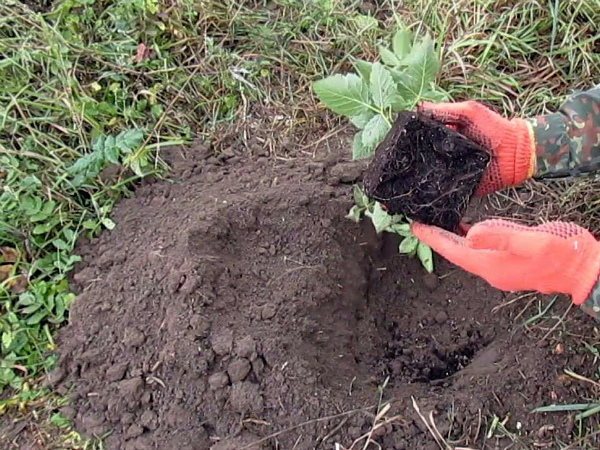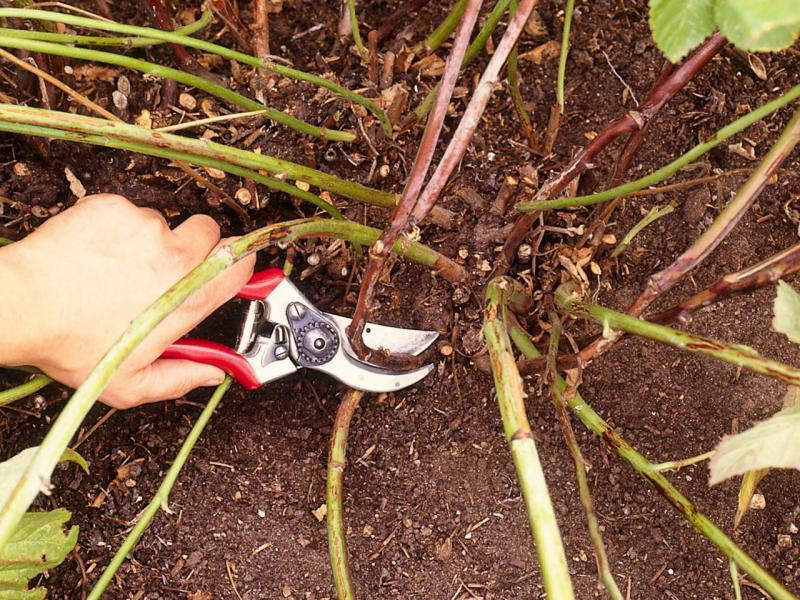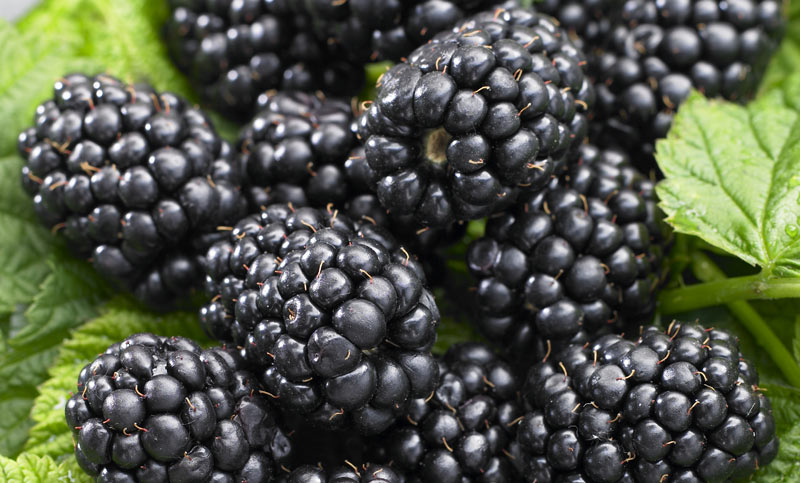Blackberries are superior to raspberries in yield, taste for demanding gourmets also seems brighter, however, the bush began to gain popularity only in the last 3-5 years. Previously, mainly southern forms of the plant were on sale, which only bore fruit well in warm regions, the bushes were characterized by uncontrolled growth and a large number of thorns. Modern catalogs are filled with winter-hardy, non-bearing and large-fruited varieties of berries, many of them have already been tested and show good results. Blackberry garden: planting and care, 5 golden pruning rules, how to cover for the winter.
Content
Features autumn planting garden blackberry
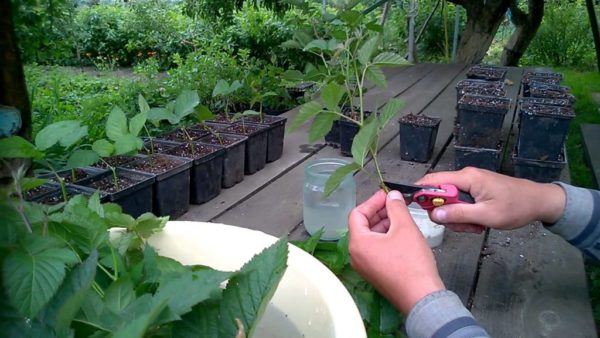 Shrubs can be planted in the spring, but autumn planting is preferable, since most often this time is accompanied by warm, rainy weather. Before the first frosts, seedlings manage to take root and develop immunity. During the winter, the bushes will harden, get used to the growing conditions, and will actively grow in the spring. Benefits of Autumn Planting Blackberry:
Shrubs can be planted in the spring, but autumn planting is preferable, since most often this time is accompanied by warm, rainy weather. Before the first frosts, seedlings manage to take root and develop immunity. During the winter, the bushes will harden, get used to the growing conditions, and will actively grow in the spring. Benefits of Autumn Planting Blackberry:
- it is recommended to plant the crop in well-warmed soil, in the spring the earth can warm up for a long time, until the onset of heat detrimental to weakened plants;
- only bushes planted in spring are exposed to the negative effects of sunlight. Burns will appear on the leaves and bark, shoot growth will slow down, this can lead to the death of the plant;
- a shrub planted in early autumn takes root faster than during spring planting;
- next year's autumn seedlings are stronger, easily tolerate weather changes;
- Nurseries and gardening shops exhibit most of the seedlings in the fall, by spring the assortment is much smaller, for the most part there is an illiquid stock.
For everything to go well, planting dates should be correctly determined, they depend on the climate. In the south and in the middle lane, a plant planted in the fall will increase the root mass until stable frosts start from - 4 degrees. In such conditions, the first time in October will be the best time to land. In cities with cooler weather, the procedure is postponed to the beginning of October. When calculating the terms, orient yourself on a long-term weather forecast, set a date 30–40 days before the first frost.
How to choose seedlings for autumn planting
The preservation and development of the bush depends on the quality of the planting material. Underdeveloped, diseased plants or improperly selected varieties will grow very slowly, if the bush does not die, then the first harvest will have to wait a very long time. Remember some useful tips to help you make the right choice when choosing blackberry garden seedlings:
- look for zoned varieties;
- consider the ripening time of berries;
- buy seedlings in verified places where the seller can provide a certificate confirming the variety;
- seedlings with an open root are best planted in the spring, in the fall choose bushes in containers;
- carefully inspect the seedling, there should not be dry areas, spots, cracks and traces of diseases on the bark;
- consult with the seller, find out all the characteristics of the variety in order to comply with the correct timing and planting patterns;
- give preference to varieties without thorns, it is much easier to plant and care for them;
- the formation of berries on the annual shoots of repairing blackberry varieties requires painstaking care, but plants that produce several waves of flowering and hybrids have an increased immunity to diseases.
In the case when you get a seedling without a container, inspect the root, it should be well developed with many thin branches. A bush can have several shoots with a thickness of at least 50 mm. When buying a seedling, consider the ability of the plant to shoot formation. If you want to plant several bushes in one row, the plant should give as little root offspring as possible.
Site selection and soil preparation
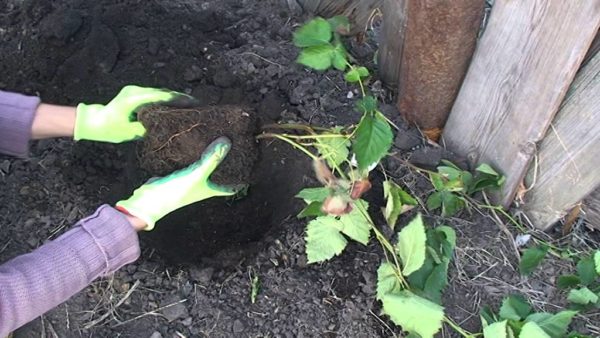 Blackberries need to allocate protected from the wind from all sides, the sunny area, in the shade of the berries will be small and sour. The shrub does not take root well and develops in arid places, however, stagnation of water affects the culture destructively, the roots quickly decay, the bush dries out. In the lowlands from the constant accumulation of moisture, the ripening of the shoots will slow down, in the winter the bushes will die even with good care. Groundwater should be located at a depth of not less than 1, 6 m. For planting a berry, sections along fences located on the south or south-west side of the garden are ideal.
Blackberries need to allocate protected from the wind from all sides, the sunny area, in the shade of the berries will be small and sour. The shrub does not take root well and develops in arid places, however, stagnation of water affects the culture destructively, the roots quickly decay, the bush dries out. In the lowlands from the constant accumulation of moisture, the ripening of the shoots will slow down, in the winter the bushes will die even with good care. Groundwater should be located at a depth of not less than 1, 6 m. For planting a berry, sections along fences located on the south or south-west side of the garden are ideal.
It is advisable that the selected place be empty for 3-5 years, blackberries should not be planted after vegetables. Solanaceous and berry crops are considered the worst predecessors; strawberries and strawberries will be bad neighbors. The berry bush grows well on fertile, water-intensive loams. Heavy, clayey carbonate soils enriched with calcium and magnesium salts, as well as sandy or rocky soil, are not suitable for a berry. The landing place is prepared in advance:
- dig deeply (45-50 cm);
- mix 5 kg of compost or rotted manure, 50 grams of potassium sulfate, 150 grams of superphosphate;
- fertilizers are evenly distributed in the selected area and once again dug.
The land is prepared 15–20 days before the intended date of planting the blackberry. The proportions of fertilizers are designed for 1 landing pit, fertilizing is enough for 3 or 4 years of vegetation. When digging, remove all weed roots. A planting hole is dug up to 50 cm deep and about 50 cm in diameter. 8 kg of compost or humus, 50 grams of superphosphate, 25 grams of potassium sulfate and 150 grams of wood ash are added to the extracted earth. The resulting mixture is poured into the hole about 2/3 of the total volume.
When determining the planting pattern, consider that for blackberries with shoots from 3, 5 to 7 m or longer, tight plantings are unacceptable. The area of nutrition will decrease, part of the branches will be in the shade, it will be more difficult to care for the plant, the quality of berries will deteriorate, yield indicators will drop, and there will be a risk of developing various diseases. The distance between seedlings may vary depending on the variety or type of culture, the arrangement of supports and agricultural practices.
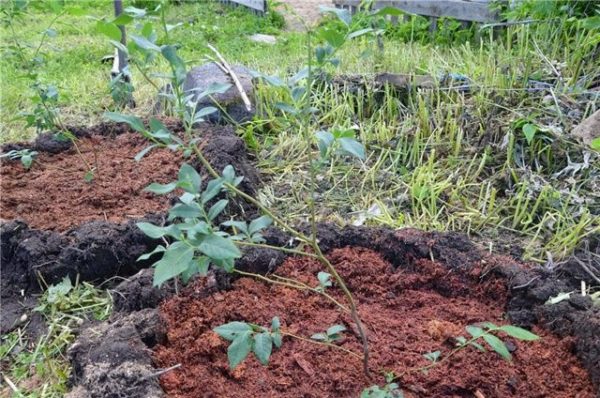 You may be interested in:
You may be interested in:|
A variety of blackberries and a method of growing |
Bushes planting scheme |
|
Rising bushes, planted in a row |
Indentation in rows - 1, 5 or 2, 5 m, row spacing of 2 m. |
|
Semi-spreading and creeping shrubs planted along the fence or on trellises |
The distance between plants in rows of 2.5–3 m, row spacing of about 2.5 m. |
|
Mothers |
Between the bushes in a row leave 3 meters, aisles from 1, 7 to 2 m. |
|
Large horticultural lands with intensive agricultural technology |
The distance between the bushes in the rows is from 70 cm to a meter, and between the rows about 2 m. |
When planting a blackberry along the fence or walls of buildings, indentation is done at least a meter. It is convenient to let the branches of the bush on the trellis, while the plants are planted in a row. It is better to place the supports in 2 rows (bushes in the middle), young shoots are sent in one direction, which later cover, second-year plants are launched on the second side, they are completely cut out in autumn.
Planting a blackberry in the fall: step-by-step instructions
Proper planting will be the key to a good wintering of blackberries and further proper development. In the case when the seedling is purchased in a container, there will be no difficulties with planting, especially if the pot is made of material that can be decomposed in the ground. If the container is made of plastic or other inorganic material, carefully remove the plant, you do not need to shake the ground.
In a seedling with an open root system, you need to carefully examine the root, trim dry areas and treat it with a weak solution of potassium permanganate or dip in a mash of mullein, clay and water in a ratio of 1: 2: 5. Before using the mixture, to protect the roots from parasites and enrich them with oxygen, they are immersed for 5 minutes in a solution of hydrogen peroxide (a teaspoon of the drug per liter of water).
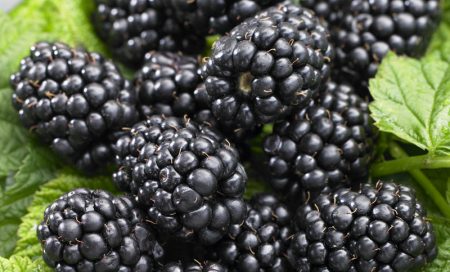 You may be interested in:
You may be interested in:How to plant a bush:
- Pour half a bucket of water into the planting pit.
- Once water is absorbed into the ground, set a seedling in the middle of the pit.
- Holding the seedling strictly perpendicularly fill the hole with the remains of the soil mixture, in the process, compact the earth a little so that there are no voids.
- The root neck is buried no more than 3 cm from the previous level.
If you did not have the opportunity to prepare the pit in advance, then pour a layer of humus about 10 cm into the dug hole (50 × 50). Place the seedling with a closed root system on a nutrient pillow, and with the earth open on a small, prepared tubercle. Immediately after planting under one bush, pour 3 buckets of water, tamp the earth a little and sprinkle a trunk circle with mulch (peat or rotted manure, a layer of 10-15 cm).
It is advisable to plant root shoots from the end of June to the beginning of September, usually the culture is planted in September. Carefully dig a side shoot, cut the root with a knife or a shovel. The separated bush is immediately transplanted to the prepared site. If you did not have time to plant a garden blackberry in the fall, leave the seedlings in the basement (in the container) until spring at a temperature of 0 to +2 degrees with periodic moistening of the soil or drop a bush in the ground on the street and carefully cover it.
Blackberry garden: pruning and preparation for winter
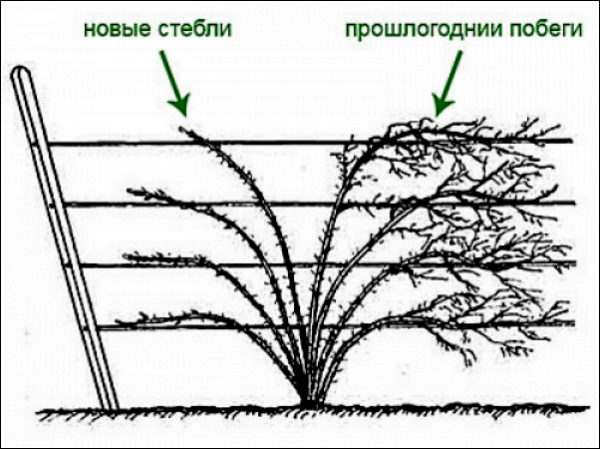 Care in autumn for blackberry seedlings consists in weeding weeds, watering (as necessary so that the soil does not dry out), loosening the soil and mulching, it will not be out of place to protect the bushes from insects hiding before wintering in the soil. To destroy pests, each bush is periodically covered with a solution of half a tablespoon of 3% hydrogen peroxide per liter of water before hiding. The same liquid can be used to treat the aerial part of the plant for the prevention of diseases.
Care in autumn for blackberry seedlings consists in weeding weeds, watering (as necessary so that the soil does not dry out), loosening the soil and mulching, it will not be out of place to protect the bushes from insects hiding before wintering in the soil. To destroy pests, each bush is periodically covered with a solution of half a tablespoon of 3% hydrogen peroxide per liter of water before hiding. The same liquid can be used to treat the aerial part of the plant for the prevention of diseases.
In subsequent years, the bushes are watered 3 times a season, the roots of the bush go deep into the ground, where they receive the necessary moisture. Even with sparse and scarce waterings, the blackberry grows in one place up to 9–11 years. The last watering is carried out a couple of weeks before the onset of frost, at the same time the fertilizer is applied (potassium phosphorus without chlorine). Under each bush, you can gently dig a small amount of a mixture of superphosphate with compost.
Blackberry pruning in the fall
The formation of a bush in the fall helps the blackberry to overwinter well and form fruit buds. In addition to preserving productivity and increasing productivity, pruning will be the key to proper, even nutrition of the bush, providing fruitful branches with sunlight, and obtaining earlier, tasty berries. Particularly important is pruning prickly blackberries, with strong overgrowth of bushes, it will become quite difficult to take care of them and pick berries. Autumn pruning is carried out from mid-September to the end of October (immediately after the harvest).
Before pruning, you need to determine the optimal load of the bush. The root of a healthy, adult plant is able to provide nutrition for no more than 8 fruitful shoots, about 10 branches are left for wintering, providing a small margin in case of freezing. All weakened stems are harvested, rare but healthy bushes are more productive. Consider 5 Golden Rules blackberry trimmings:
- The first year during the season, all inflorescences are cut off to stimulate root growth.
- In the second year, in the spring before the start of the growing season, the stems are shortened to 1, 5 or 1, 7 m. Sections are made above the kidney.
- After wintering, frozen sections of the stems are removed to a living bud. In the first half of June, the bush is thinned out - young shoots are removed, leaving no more than 8 of the best shoots for creeping species and about 5 for straight-growing ones. The tips of young stems are shortened by 6 or 8 cm (a centimeter above the kidney).
- In the fall, fruiting branches are cut under the root, as well as underdeveloped shoots or affected by diseases and pests.
- Bushes of a repairing blackberry are completely cut out.
To make blackberries quicker after trimming, use only sharp scissors or a pruner with no gaps between the blades. The branches are cleaned completely, even short stumps cannot be left; if the wood rots, there is a risk of developing dangerous diseases. All plant debris is strictly forbidden to leave near the bushes, they are burned away from the beds with blackberries.
How to Cover Blackberry
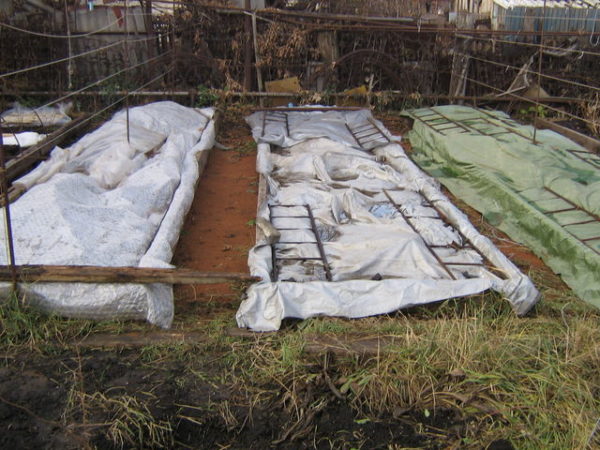 Autumn planting of blackberries involves the organization of a reliable shelter. In warm regions with snowy winters, you can do without additional protection, a layer of mulch will be enough. Before wintering, the stems are shortened to 1, 5–1, 8 m. If in your area in winter the snow cover is less than 30 cm, then the seedlings must be bent to the ground, tied to pegs and covered with burlap, roofing felt or thick polyethylene. The ground should be covered with a layer of hay, straw, peat, spruce branches, tops of corn or sunflower.
Autumn planting of blackberries involves the organization of a reliable shelter. In warm regions with snowy winters, you can do without additional protection, a layer of mulch will be enough. Before wintering, the stems are shortened to 1, 5–1, 8 m. If in your area in winter the snow cover is less than 30 cm, then the seedlings must be bent to the ground, tied to pegs and covered with burlap, roofing felt or thick polyethylene. The ground should be covered with a layer of hay, straw, peat, spruce branches, tops of corn or sunflower.
It is necessary to cover the blackberry immediately before the onset of frost, if the procedure is carried out too early, there is a risk that the shoots pressed to the ground will take root. In spring, the protection is removed immediately after the temperature has reached zero, so that the branches do not overheat, and the fruit buds do not become barred. The lashes are tied to the supports as they grow.Blackberry shoots are difficult to bend, so the bushes have been preparing for the subsequent shelter since August - small weights are attached to the tips of the annual branches, the stems will gradually tilt.
Mistakes in caring for a blackberry in autumn and preparing for winter
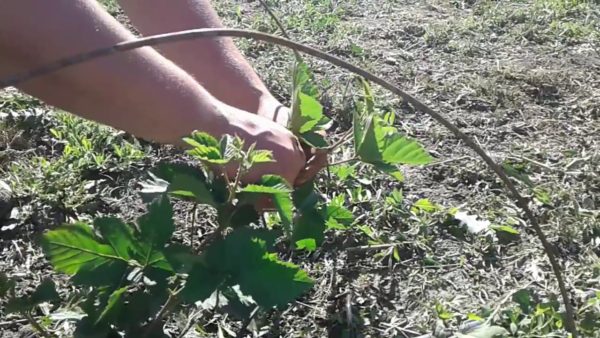 Beginners, and sometimes experienced gardeners complain that, subject to all the rules of the autumn planting of blackberries, the bush next year is very poorly developed and constantly sick. The problem may lie in poor-quality planting material, but most often weak growth is a sign of improper care. What mistakes gardeners make when growing a garden blackberry:
Beginners, and sometimes experienced gardeners complain that, subject to all the rules of the autumn planting of blackberries, the bush next year is very poorly developed and constantly sick. The problem may lie in poor-quality planting material, but most often weak growth is a sign of improper care. What mistakes gardeners make when growing a garden blackberry:
- too thick landing;
- planting in a moist place (it is better to transplant the bush immediately);
- improper crown formation;
- lack of normalization of shoots (overload of the bush);
- untimely pruning.
In the cultivation of blackberries, every detail is important, many varieties and hybrids, although they are unpretentious, but still require increased attention. Start growing berries only after a thorough study of the theory of autumn planting and care for blackberries. Consider the climatic conditions of the region and the composition of the soil, only then you can get excellent berry yields annually.
Differences planting blackberries in different areas
Outdoor planting and care are the same for all regions of Russia, but there are some nuances. Studying the experience of gardeners from different areas, you can notice that the same events can both harm and benefit the plant. For example, in the Moscow Region, blackberries should be watered infrequently and not abundantly, and in the Krasnodar Territory, on the contrary, as often as possible. Let's note the most important points:
- The Northwest region is a rather problematic area for gardeners and gardeners, for the most part cities are located in wetlands. It is advisable to place the shrub on slopes, hills, or when preparing planting pits, pour a large layer of drainage material.
- The central region and the Moscow Region - winters are mostly frosty, and in summer and early autumn often there is insufficient humidity. After planting in October or November (rainy periods), the soil in the near-stem circle is loosened after each rain or watering, and before the onset of frost, a high layer of mulch is laid as protection against frost.
- Krasnodar Territory - the area is characterized by a hot climate with low rainfall. Almost the entire summer and autumn season, a dry, hot wind blows, bringing prolonged drought. In such conditions, blackberries should be planted in late autumn or winter, until mid-December. Watering is recommended often, and be sure to mulch not only the trunk circles, but also the aisles.
- Siberia is a zone of risky farming; here, from year to year, severe frosts and winds are observed. Blackberries are planted in unshaded places, protected by walls of buildings or fences. All work with blackberries should be completed before the first autumn frosts (to mulch, cover the beds and put up shields to hold the snow).
Now you know how to plant a blackberry in the fall, if you correctly carry out the procedure and organize high-quality care, the bushes will easily tolerate winter frosts and quickly set in growth in spring, you won’t have to wait long for the first harvest. To avoid problems, remember the basic nuances of gardening blackberry care, and feel free to breed the best varieties of fortified, still rare berries in your area.

